Angela Ackerman's Blog: Writers Helping Writers, page 162
September 9, 2013
A Deep Loss: Author Carolyn Kaufman Passes Away
Becca and I would like to extend our condolences to the family and friends of Dr. Carolyn Kaufman, who passed away suddenly this weekend of a brain aneurysm. Carolyn was a very giving, kind person, sharing her wisdom at her blog, Archetype Writing and also at QueryTracker & Psychology Today. She is also the author of the excellent resource,
A Writer's Guide to Psychology
.

We worked closely with Carolyn this summer as she helped us with the content of our upcoming book, The Negative Trait Thesaurus: A Writer's Guide To Character Flaws. Carolyn aided us with some of the psychology aspects of the book, and very generously took the time to write the foreword for us.
It was such a terrible shock to hear the news. Carolyn was so supportive, and her confidence and enthusiasm for our book boosted Becca and I up in so many ways. We are both so grateful to have known her. She will be greatly missed.
When I started writing and seriously working to improve my craft, Archetype Writing was one of the first blogs I found. I continually returned to it to soak of Carolyn's wisdom and over the years have learned so much from her, as have many others.
You can read her full obituary here and Querytracker has also posted about Carolyn's passing.


We worked closely with Carolyn this summer as she helped us with the content of our upcoming book, The Negative Trait Thesaurus: A Writer's Guide To Character Flaws. Carolyn aided us with some of the psychology aspects of the book, and very generously took the time to write the foreword for us.
It was such a terrible shock to hear the news. Carolyn was so supportive, and her confidence and enthusiasm for our book boosted Becca and I up in so many ways. We are both so grateful to have known her. She will be greatly missed.
When I started writing and seriously working to improve my craft, Archetype Writing was one of the first blogs I found. I continually returned to it to soak of Carolyn's wisdom and over the years have learned so much from her, as have many others.
You can read her full obituary here and Querytracker has also posted about Carolyn's passing.

Published on September 09, 2013 03:30
September 6, 2013
Need Online Exposure? Asking Bloggers For Help
Yesterday I posted a tip on Facebook regarding the wrong way to contact bloggers for exposure after being “cold call” emailed myself. The cliff note version is that a marketing person sent me a form letter asking for
book exposure, and supplied 4 attachments that contained book covers,
press releases, links, etc.
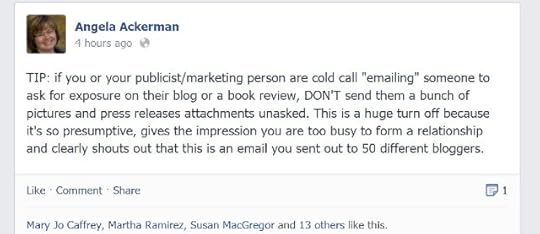
This prompted some discussion on Facebook and in email about what the protocol is for contacting bloggers or website owners for a promotion opportunity, especially if one does not have a strong online presence and so can't reciprocate (such as trading guest posts). I know reaching outside one's comfort zone to ask for help can be a difficult thing to do, so based on my personal experience from both sides of this fence, here's some tips on how to ask!
1) Do your homework
I'll be honest...nothing bugs me more than to be contacted by someone who has looked at my blog's SEO score or glanced at my traffic meter (which is way off the mark anyway) but knows nothing about The Bookshelf Muse. Asking me to review business software, jewelry, iPad products or anything else that has nothing to do with my blog's focus is NOT going to win me over. So, when you are looking for online exposure, research blogs to understand what they are about, what they typically post, and only add them to your list to contact if you see a strong fit. This means knowing YOUR audience before you get started. Also, if you are looking for a book review, make sure the people you wish to contact actually DO REVIEWS, and if so, that they REVIEW YOUR GENRE. If they have instructions for contacting them, follow those instructions.
2) Show respect
First off, while it certainly is easier to send out a cut-and-paste email to 50 or so blogs or websites asking for help, what saves you time will cost you in exposure. Anyone with any measure of success online understands that relationships are paramount. If you did your homework in step 1, you have researched the person you are contacting. Personalize email by introducing yourself and demonstrating that you have visited the person's blog, and understand & enjoy the content. Be authentic and friendly, and respectful of their time.
3) Offer information, but don't go overboard
Whatever exposure opportunity you're asking for will require some specific information. Be clear and concise about what your offering, be it a book, product or service. Convey why your product is a good fit for the blog/blogger and their audience, showing you have knowledge of this person's site. Provide a link if needed to the product online, or lacking that, links to how to reach you. DON'T send them your book or product proactively, or a bunch of press release attachments and book covers or promotional information. Would you send your manuscript along with a query letter to an agent who has not asked for both? No. So offer to forward these things if the blogger wants them and welcome the chance to answer any questions they may have.
4) Offer value, not promo
Your goal is to get a YES when it comes to asking for an exposure opportunity, so make it easy for them to do so. When you approach a blogger, know what you are asking for. If it is a review site, then ask for a review and in turn offer something of value. A free book to the reviewer will be expected, but consider also offering one in a giveaway. Giveaways usually increase traffic, so the expense will be worth it if you have chosen a site that exposes you to your ideal audience. If it is a product or service, or book exposure that is not a review, consider what this audience might find valuable. Can you guest post on a topic that fits well with this blog's focus? Can you offer your expertise in a way that readers will find helpful (a Q & A about something you know a lot about, for example.) A freebie of some sort, or something else? Whatever you can offer, lay this out. Offer a few options (for example, list out a few ideas you have for a post), but be flexible and open to whatever ideas they have for you, too. Exposure is an opportunity to CONNECT with an audience and build a relationship with people interested in what you have to say, not a way to spam people with promo. Always add value in all that you do.
5) Be easy to work with
Bloggers are busy people. The bigger bloggers especially have a lot to juggle, because they are likely active across different social media platforms, plus have their own lives and work to attend to. Once you've secured a guest post or exposure opportunity, make sure you send them whatever is required in a timely manner. Also, don't just "dash something off" (especially if you are a writer!) Write something you're proud of and make sure it offers insight and value. Check carefully for typos and grammar. Bloggers appreciate it when you do a good job the first time so they don't waste time sending it back to you for editing. Provide links that are easy to follow for the audience, and make sure there is a way for readers to find out more about your product. Include a small bio about yourself and where you can be found (twitter, facebook, website, etc.) so the blogger doesn't have to spend time looking for these things themselves.
6) Show up, interact and share
The day your post goes live, stop in and interact with people in the comment section. This is your opportunity to make yourself memorable to people who took the time to read what you had to say. Thank your host for having you. Continue to add value by answering questions, both the day of the post and a few check-ins afterward (some people won't see the post until the next day or so). Wherever you are online (even if you only use Facebook, or Twitter, etc.) make sure you share your post with people who might be interested in the content. When you ask someone for exposure, you thank them by trying to drive people to their blog however you are able to. Don't spam, but do share the link with people who you feel might be interested.
7) Keep on asking
Maybe you might strike out a few times, but that's okay...keep going! I know asking for things can be intimidating, but here's the thing...most people are caring and helpful and want to build relationships. If we didn't, we wouldn't blog, or be on facebook or twitter. So try to set your nerves aside and be genuine. When you are, it comes through, and often leads to a Yes!
Other posts you might find helpful:
Our Path To 10K In Sales: Strategy, Luck & Mistakes
Blogging: Know Your Audience
Marketing for Introverts
Making Your Book Launch Stand Out
Creative Book Launches That Command Attention
Any tips on contacting bloggers that you'd like to share? I'd love to hear them!

book exposure, and supplied 4 attachments that contained book covers,
press releases, links, etc.

This prompted some discussion on Facebook and in email about what the protocol is for contacting bloggers or website owners for a promotion opportunity, especially if one does not have a strong online presence and so can't reciprocate (such as trading guest posts). I know reaching outside one's comfort zone to ask for help can be a difficult thing to do, so based on my personal experience from both sides of this fence, here's some tips on how to ask!
1) Do your homework
I'll be honest...nothing bugs me more than to be contacted by someone who has looked at my blog's SEO score or glanced at my traffic meter (which is way off the mark anyway) but knows nothing about The Bookshelf Muse. Asking me to review business software, jewelry, iPad products or anything else that has nothing to do with my blog's focus is NOT going to win me over. So, when you are looking for online exposure, research blogs to understand what they are about, what they typically post, and only add them to your list to contact if you see a strong fit. This means knowing YOUR audience before you get started. Also, if you are looking for a book review, make sure the people you wish to contact actually DO REVIEWS, and if so, that they REVIEW YOUR GENRE. If they have instructions for contacting them, follow those instructions.
2) Show respect
First off, while it certainly is easier to send out a cut-and-paste email to 50 or so blogs or websites asking for help, what saves you time will cost you in exposure. Anyone with any measure of success online understands that relationships are paramount. If you did your homework in step 1, you have researched the person you are contacting. Personalize email by introducing yourself and demonstrating that you have visited the person's blog, and understand & enjoy the content. Be authentic and friendly, and respectful of their time.
3) Offer information, but don't go overboard
Whatever exposure opportunity you're asking for will require some specific information. Be clear and concise about what your offering, be it a book, product or service. Convey why your product is a good fit for the blog/blogger and their audience, showing you have knowledge of this person's site. Provide a link if needed to the product online, or lacking that, links to how to reach you. DON'T send them your book or product proactively, or a bunch of press release attachments and book covers or promotional information. Would you send your manuscript along with a query letter to an agent who has not asked for both? No. So offer to forward these things if the blogger wants them and welcome the chance to answer any questions they may have.
4) Offer value, not promo
Your goal is to get a YES when it comes to asking for an exposure opportunity, so make it easy for them to do so. When you approach a blogger, know what you are asking for. If it is a review site, then ask for a review and in turn offer something of value. A free book to the reviewer will be expected, but consider also offering one in a giveaway. Giveaways usually increase traffic, so the expense will be worth it if you have chosen a site that exposes you to your ideal audience. If it is a product or service, or book exposure that is not a review, consider what this audience might find valuable. Can you guest post on a topic that fits well with this blog's focus? Can you offer your expertise in a way that readers will find helpful (a Q & A about something you know a lot about, for example.) A freebie of some sort, or something else? Whatever you can offer, lay this out. Offer a few options (for example, list out a few ideas you have for a post), but be flexible and open to whatever ideas they have for you, too. Exposure is an opportunity to CONNECT with an audience and build a relationship with people interested in what you have to say, not a way to spam people with promo. Always add value in all that you do.
5) Be easy to work with
Bloggers are busy people. The bigger bloggers especially have a lot to juggle, because they are likely active across different social media platforms, plus have their own lives and work to attend to. Once you've secured a guest post or exposure opportunity, make sure you send them whatever is required in a timely manner. Also, don't just "dash something off" (especially if you are a writer!) Write something you're proud of and make sure it offers insight and value. Check carefully for typos and grammar. Bloggers appreciate it when you do a good job the first time so they don't waste time sending it back to you for editing. Provide links that are easy to follow for the audience, and make sure there is a way for readers to find out more about your product. Include a small bio about yourself and where you can be found (twitter, facebook, website, etc.) so the blogger doesn't have to spend time looking for these things themselves.
6) Show up, interact and share
The day your post goes live, stop in and interact with people in the comment section. This is your opportunity to make yourself memorable to people who took the time to read what you had to say. Thank your host for having you. Continue to add value by answering questions, both the day of the post and a few check-ins afterward (some people won't see the post until the next day or so). Wherever you are online (even if you only use Facebook, or Twitter, etc.) make sure you share your post with people who might be interested in the content. When you ask someone for exposure, you thank them by trying to drive people to their blog however you are able to. Don't spam, but do share the link with people who you feel might be interested.
7) Keep on asking
Maybe you might strike out a few times, but that's okay...keep going! I know asking for things can be intimidating, but here's the thing...most people are caring and helpful and want to build relationships. If we didn't, we wouldn't blog, or be on facebook or twitter. So try to set your nerves aside and be genuine. When you are, it comes through, and often leads to a Yes!
Other posts you might find helpful:
Our Path To 10K In Sales: Strategy, Luck & Mistakes
Blogging: Know Your Audience
Marketing for Introverts
Making Your Book Launch Stand Out
Creative Book Launches That Command Attention
Any tips on contacting bloggers that you'd like to share? I'd love to hear them!

Published on September 06, 2013 04:00
September 2, 2013
Hand-Selling Your Book: How Savvy Are You?
Earlier in August, I attended a 3-day conference for writers and readers called When Words Collide. This unique event had lectures on writing technique, publishing options and content that focused on the business of writing. I attended sessions on everything from Quantum Theory (great for plot lines that deal with parallel worlds!) to Building Author Websites, to Understanding Patterns of Recognition in Readers, to The Role of Violence in Literature. All this for $55 dollars. AMAZING VALUE. If you live near Calgary Alberta or would like to visit, do check out next year's conference!

One of the neat things about this conference is that they had a large bookstore for local indie booksellers, Canadian publishers, and indie authors. Anyone who presents workshops or sits on panels at the conference is invited to have their book available, so of course I took advantage of this. (SIDE NOTE: meeting fans of The Emotion Thesaurus was SO awesome!)
I took a few shifts at a table to help sell books, as did many other authors. Because I like to watch people (er, not in a El Creepo way or anything) I made some observations on those working the various bookstore tables and how their behavior affected those browsing for books. The good and bad selling strategies I observed split equally between self-published and traditionally published authors.
Body Language:
DESPERATE-FOR-THE-SALE: types leaned forward on their chair or hovered near their books like a jack-in-the-box ready to spring. They watched shoppers and kept a bead on anyone moving toward their table.
SMART SELLERS: appeared relaxed and non-threatening, or busied themselves tidying the table (re-stacking all the books, straightening business cards and fanning out bookmarks). They glanced up occasionally but avoided continual eye contact.
THE DIFFERENCE BETWEEN THE TWO: When I wandered the room as a buyer, I found I either felt like a piece of meat or a window shopper, depending on the body language of the people behind the table.
First Interaction:
DESPERATE-FOR-THE-SALE: once a customer started browsing the table, the seller asked a direct question that would hopefully lead to a personal sale. This might be anything from, "So, do you read Fantasy/Romance/Memoir/X genre?" and if they answered correctly, the seller would nudge attention toward their book. In one case I heard someone say, "You need this book." If they answered a different genre than the author's book, a follow up question might be, "Well, have you ever tried X genre?"
SMART
SELLERS: asked an indirect question after a few moments of browsing. This ranged from "So, are you enjoying the conference?" or "Are you a reader, or a writer?" which led to some conversation about the WWC event and then to either questions about what the buyer read or what they wrote.
THE DIFFERENCE BETWEEN THE TWO: I observed that if the seller was too direct, the buyer would move on to another table, or they would stay and avoid that author's book (sometimes checking out the person's name tag and seeing if it matched a book!) People were there to browse so if the person behind the table let them do so for a minute before speaking to them, this seemed to encourage them to hang around a bit longer.
Conversing:
DESPERATE-FOR-THE-SALE: if the browser stayed, this type of seller wasted little time to insert a mention of their book into the conversation. This could be anything from, "Yes, editing is hard isn't it? I think I did seven revisions for my last book before my publisher was happy with it." which would sometimes get a polite nod if the author was being too obvious, and other times spur more conversation: "Oh, so you're published?" or, "You have a book--is it here?" which could lead to a sale. Sometimes the seller would try to make a comparison: "The book you're writing sounds a bit like my book, Radical Racers: An Uncharted Journey--" *points* "--which is also about a teenager who struggles with his parents." Again, depending on how obvious the author was, this might reek of trying too hard or encourage another look.
SMART
SELLERS: followed up on the initial indirect question. This might be, "So what was your
favorite panel so far?" or "What book are you reading right now?"which lead to
some conversation about the WWC event and start a discussion about books, allowing the seller to learn about the reader's tastes.
THE
DIFFERENCE BETWEEN THE TWO: Often if the seller was pushy or obvious about trying to draw attention to their book, the potential reader would leave as politely as possible or make a comment that shut out further pitching. "I usually only read Steampunk," or "Well, I better go so I can make the next panel." If the
person behind the table seemed more interested in conversing in general, they stuck around to talk and look.
Author-As-Seller Styles:
There seemed to be a few styles of selling. The first was ME FOCUSED, where the seller was generally only interested in talking to potential readers to make them aware of their book. If they discussed the reader's interests, they would bring the conversation around to what they had on the table as soon as possible. Me focused types were on a mission, and often stopped engaging when it was clear the person would not be buying their book. They rarely if ever suggested other books on the table to the reader because many hadn't bothered to read the back jacket blurbs.
SAVVY SELLERS would engage browsers in conversation, and work on a relationship, trying to encourage light back and forth. They asked questions that didn't make the other person uncomfortable. If someone picked up a book that wasn't theirs, they sometimes commented on it, talking about the cover or plot if they knew it. They also put buyers at ease, asking about their writing or reading habits, discussed books they'd read in common and would gently draw attention to their book if an opportunity presented itself (for example, if the person picked it up they might say, "That one's mine. Do you read a lot of fantasy?" Or they might say, "Are you a bookmark collector like me? Would like one of mine?" subtly drawing attention that their book is on display. If the buyer was also a writer or they shared some personal ground, the seller might ask, "Do you blog/have a website/are you on twitter?" and if so, they would ask for a business card to connect with them online. This often led to a card exchange. Savvy sellers made connection regardless of whether they made a sale and became memorable in the browser's mind.
DON'T WANT TO DO THIS BUT I HAVE TO types avoided eye contact, texted and checked their phones constantly, And talked to their table mates so they wouldn't have to strike up conversations with buyers. They only talked to customers when they handled money after a buyer had made their choice. The don't want to do this types missed a big opportunity to interact with readers, draw attention to their books and make a positive impression.
UNCOMFORTABLE WITH HAND-SELLING authors knew the books on the table
and would engage browsers in conversation. They would make recommendations based on the reader's interests, but not bring up their own book. This appeared to build trust and a
relationship, which sometimes led to the browser to ask a bit about the
seller, or cause them to check out their name tag to see if it matched anything
on the table. They would often then pick up the book and ask about it, and while the author would respond and engage, the reader had to do the asking to get to that point. This could come across as humility to browsers or suggest to them the author was not confident in their own book. Sometimes sales would happen, sometimes not, but if the potential buyer moved on without knowing the person they enjoyed talking to even had a book, it was a wasted opportunity.
So...which was I? If I'm honest, I tried for savvy but leaned a bit toward the uncomfortable hand-seller in the sense that I didn't point out my book or mention it unless people made the connection it was mine or actually had it in their hands. Instead I tried hard to make people feel comfortable by asking what they wrote, and what they were enjoying about the conference. I definitely swapped business cards, and if people struggled with certain areas of writing where my blog could help, I mentioned it. If I knew other good sources of information that fit their needs or books that ran along their interest, I mentioned those as well. I didn't obsessively watch people, I paid attention to the people who clearly wanted to browse in peace, and I only checked my email if the traffic had dropped off to nothing.
I know that I need to become more comfortable being an advocate of my book, but I struggle with how to do that and not feel pushy. So tell me, what techniques do you employ to hand sell your books? If you are the buyer, what turns you off, and what causes you to give a new book a try?


One of the neat things about this conference is that they had a large bookstore for local indie booksellers, Canadian publishers, and indie authors. Anyone who presents workshops or sits on panels at the conference is invited to have their book available, so of course I took advantage of this. (SIDE NOTE: meeting fans of The Emotion Thesaurus was SO awesome!)
I took a few shifts at a table to help sell books, as did many other authors. Because I like to watch people (er, not in a El Creepo way or anything) I made some observations on those working the various bookstore tables and how their behavior affected those browsing for books. The good and bad selling strategies I observed split equally between self-published and traditionally published authors.
Body Language:
DESPERATE-FOR-THE-SALE: types leaned forward on their chair or hovered near their books like a jack-in-the-box ready to spring. They watched shoppers and kept a bead on anyone moving toward their table.
SMART SELLERS: appeared relaxed and non-threatening, or busied themselves tidying the table (re-stacking all the books, straightening business cards and fanning out bookmarks). They glanced up occasionally but avoided continual eye contact.
THE DIFFERENCE BETWEEN THE TWO: When I wandered the room as a buyer, I found I either felt like a piece of meat or a window shopper, depending on the body language of the people behind the table.
First Interaction:
DESPERATE-FOR-THE-SALE: once a customer started browsing the table, the seller asked a direct question that would hopefully lead to a personal sale. This might be anything from, "So, do you read Fantasy/Romance/Memoir/X genre?" and if they answered correctly, the seller would nudge attention toward their book. In one case I heard someone say, "You need this book." If they answered a different genre than the author's book, a follow up question might be, "Well, have you ever tried X genre?"
SMART
SELLERS: asked an indirect question after a few moments of browsing. This ranged from "So, are you enjoying the conference?" or "Are you a reader, or a writer?" which led to some conversation about the WWC event and then to either questions about what the buyer read or what they wrote.
THE DIFFERENCE BETWEEN THE TWO: I observed that if the seller was too direct, the buyer would move on to another table, or they would stay and avoid that author's book (sometimes checking out the person's name tag and seeing if it matched a book!) People were there to browse so if the person behind the table let them do so for a minute before speaking to them, this seemed to encourage them to hang around a bit longer.
Conversing:
DESPERATE-FOR-THE-SALE: if the browser stayed, this type of seller wasted little time to insert a mention of their book into the conversation. This could be anything from, "Yes, editing is hard isn't it? I think I did seven revisions for my last book before my publisher was happy with it." which would sometimes get a polite nod if the author was being too obvious, and other times spur more conversation: "Oh, so you're published?" or, "You have a book--is it here?" which could lead to a sale. Sometimes the seller would try to make a comparison: "The book you're writing sounds a bit like my book, Radical Racers: An Uncharted Journey--" *points* "--which is also about a teenager who struggles with his parents." Again, depending on how obvious the author was, this might reek of trying too hard or encourage another look.
SMART
SELLERS: followed up on the initial indirect question. This might be, "So what was your
favorite panel so far?" or "What book are you reading right now?"which lead to
some conversation about the WWC event and start a discussion about books, allowing the seller to learn about the reader's tastes.
THE
DIFFERENCE BETWEEN THE TWO: Often if the seller was pushy or obvious about trying to draw attention to their book, the potential reader would leave as politely as possible or make a comment that shut out further pitching. "I usually only read Steampunk," or "Well, I better go so I can make the next panel." If the
person behind the table seemed more interested in conversing in general, they stuck around to talk and look.
Author-As-Seller Styles:
There seemed to be a few styles of selling. The first was ME FOCUSED, where the seller was generally only interested in talking to potential readers to make them aware of their book. If they discussed the reader's interests, they would bring the conversation around to what they had on the table as soon as possible. Me focused types were on a mission, and often stopped engaging when it was clear the person would not be buying their book. They rarely if ever suggested other books on the table to the reader because many hadn't bothered to read the back jacket blurbs.
SAVVY SELLERS would engage browsers in conversation, and work on a relationship, trying to encourage light back and forth. They asked questions that didn't make the other person uncomfortable. If someone picked up a book that wasn't theirs, they sometimes commented on it, talking about the cover or plot if they knew it. They also put buyers at ease, asking about their writing or reading habits, discussed books they'd read in common and would gently draw attention to their book if an opportunity presented itself (for example, if the person picked it up they might say, "That one's mine. Do you read a lot of fantasy?" Or they might say, "Are you a bookmark collector like me? Would like one of mine?" subtly drawing attention that their book is on display. If the buyer was also a writer or they shared some personal ground, the seller might ask, "Do you blog/have a website/are you on twitter?" and if so, they would ask for a business card to connect with them online. This often led to a card exchange. Savvy sellers made connection regardless of whether they made a sale and became memorable in the browser's mind.
DON'T WANT TO DO THIS BUT I HAVE TO types avoided eye contact, texted and checked their phones constantly, And talked to their table mates so they wouldn't have to strike up conversations with buyers. They only talked to customers when they handled money after a buyer had made their choice. The don't want to do this types missed a big opportunity to interact with readers, draw attention to their books and make a positive impression.
UNCOMFORTABLE WITH HAND-SELLING authors knew the books on the table
and would engage browsers in conversation. They would make recommendations based on the reader's interests, but not bring up their own book. This appeared to build trust and a
relationship, which sometimes led to the browser to ask a bit about the
seller, or cause them to check out their name tag to see if it matched anything
on the table. They would often then pick up the book and ask about it, and while the author would respond and engage, the reader had to do the asking to get to that point. This could come across as humility to browsers or suggest to them the author was not confident in their own book. Sometimes sales would happen, sometimes not, but if the potential buyer moved on without knowing the person they enjoyed talking to even had a book, it was a wasted opportunity.
So...which was I? If I'm honest, I tried for savvy but leaned a bit toward the uncomfortable hand-seller in the sense that I didn't point out my book or mention it unless people made the connection it was mine or actually had it in their hands. Instead I tried hard to make people feel comfortable by asking what they wrote, and what they were enjoying about the conference. I definitely swapped business cards, and if people struggled with certain areas of writing where my blog could help, I mentioned it. If I knew other good sources of information that fit their needs or books that ran along their interest, I mentioned those as well. I didn't obsessively watch people, I paid attention to the people who clearly wanted to browse in peace, and I only checked my email if the traffic had dropped off to nothing.
I know that I need to become more comfortable being an advocate of my book, but I struggle with how to do that and not feel pushy. So tell me, what techniques do you employ to hand sell your books? If you are the buyer, what turns you off, and what causes you to give a new book a try?

Published on September 02, 2013 04:00
August 29, 2013
Writing a Whodunit: Grab Your Code For A FREE Course!
I don't know about you, but I love a good mystery. The questions and hunt for answers, the misdirections and the red herrings...when an author can weave these elements so completely that they keep me guessing until the very end, that's magic.
So this is why I'm so happy to introduce Michael Dickson, an online writing instructor at Udemy. Michael is just getting a new course up and running: Outline Your Whodunit Mystery Novel, which will help you design your plot, subplot, and story arch to outline a Whodunit mystery novel.
Because this is a new course, Michael's offering free spots in his class to Bookshelf Muse readers in exchange for an honest review of the course. So, read on and see if you'd like to try your hand at writing mystery, and snag the free code at the bottom!

Clues to a Whodunit Mystery – What are They and How do You Create Them?
Do you enjoy puzzles?
When you start one, do you search out the edge pieces first so you can be sure all the others are centered somewhere in the middle of your newly created frame?
A mystery novel is similar to a puzzle. The picture comes into view once you, the reader, place the pieces in the correct position. Just like a manufacturer provides in the box, authors give readers all the pieces to solve the puzzle. The finished "picture" in a Whodunit mystery novel is the killer, and it’s the reader's job to utilize clues the author has sprinkled about to uncover their identity.
So, what is a clue?
Clues are facts. They are the blurry colors on the puzzle piece. Each clue builds on the next until the mystery is solved, much like how the colors on each puzzle piece help the picture to come into view. Eventually you narrow your focus down to one or two pieces and solve the puzzle.
The creation of the clue within your novel is the real test to your creativity. Sure, you could have the wine glass covered in red lipstick signifying the killer may be a woman, or the note pinned to the victim’s door written in the butler’s handwriting, but with today’s intelligent readers you’ll need to be far more creative. You need to invent new ideas and original clues to walk your readers alongside the sleuth until the killer is identified.
To accomplish this, consider beginning with your suspects. Have you crafted the characters prior to writing? By having fully imagined characters before you develop the novel, you can utilize each character's distinctive trait as a starting point to creating each clue.
For example, begin with a line-up of well developed suspects. You may already have an idea of who your killer is, but for the sake of this example, start by creating scenes where each suspect is introduced to the reader and the story's detective. Through this introduction, sprinkle in ideas, dialogue, physical attributes, and items specifically associated with that character which will implicate them as a possible suspect. Do this for each character as they are introduced, and be sure to implicate several characters for each clue revealed.
You may find it helpful to create a small graph with each character listed on the top and the clues you plan to introduce to the left. As your introductions continue and the character traits, dialogue, attributes, etc. help to pile up evidence, the suspect pool will eventually narrow and you will have your killer. Or will you?
The clues you reveal through each suspect can also serve another purpose. Like the puzzle pieces you jam together, at first it seems that the picture is becoming clearer. But one misjudgement and you find out you were dead wrong. A clue can do the very same thing. These are called red herrings or false clues.
A red herring is a deceptive clue that leads the sleuth away from the killer. Red herrings can build on top of each other until they are it’s finally revealed that they are false, and have diverted attention away from the real killer. They’re a staple of the mystery novel and need to be included for your story to pack the punch the reader anticipates with today’s novels.

As I’ve described, creating clues for your mystery novel need not be a
difficult task. By taking the time to create your suspects ahead of
time, you can use your creativity to develop clues utilizing your
characters unique attributes that point both to the red herring and the
killer.
Michael M. Dickson is an author, blogger, and creator of Outline Your Whodunit Mystery Novel; (currently free for a limited time). He’s successfully taught hundreds of people his techniques to creating complete novel outlines in several genres including, mystery, young adult, romance and thrillers. You can find Michael on Twitter and Facebook.
Are you ready to start creating your own Whodunit novel? Just go HERE and type in the word, Bookshelf as your coupon code to get your FREE course!
So this is why I'm so happy to introduce Michael Dickson, an online writing instructor at Udemy. Michael is just getting a new course up and running: Outline Your Whodunit Mystery Novel, which will help you design your plot, subplot, and story arch to outline a Whodunit mystery novel.
Because this is a new course, Michael's offering free spots in his class to Bookshelf Muse readers in exchange for an honest review of the course. So, read on and see if you'd like to try your hand at writing mystery, and snag the free code at the bottom!

Clues to a Whodunit Mystery – What are They and How do You Create Them?
Do you enjoy puzzles?
When you start one, do you search out the edge pieces first so you can be sure all the others are centered somewhere in the middle of your newly created frame?
A mystery novel is similar to a puzzle. The picture comes into view once you, the reader, place the pieces in the correct position. Just like a manufacturer provides in the box, authors give readers all the pieces to solve the puzzle. The finished "picture" in a Whodunit mystery novel is the killer, and it’s the reader's job to utilize clues the author has sprinkled about to uncover their identity.
So, what is a clue?
Clues are facts. They are the blurry colors on the puzzle piece. Each clue builds on the next until the mystery is solved, much like how the colors on each puzzle piece help the picture to come into view. Eventually you narrow your focus down to one or two pieces and solve the puzzle.
The creation of the clue within your novel is the real test to your creativity. Sure, you could have the wine glass covered in red lipstick signifying the killer may be a woman, or the note pinned to the victim’s door written in the butler’s handwriting, but with today’s intelligent readers you’ll need to be far more creative. You need to invent new ideas and original clues to walk your readers alongside the sleuth until the killer is identified.
To accomplish this, consider beginning with your suspects. Have you crafted the characters prior to writing? By having fully imagined characters before you develop the novel, you can utilize each character's distinctive trait as a starting point to creating each clue.
For example, begin with a line-up of well developed suspects. You may already have an idea of who your killer is, but for the sake of this example, start by creating scenes where each suspect is introduced to the reader and the story's detective. Through this introduction, sprinkle in ideas, dialogue, physical attributes, and items specifically associated with that character which will implicate them as a possible suspect. Do this for each character as they are introduced, and be sure to implicate several characters for each clue revealed.
You may find it helpful to create a small graph with each character listed on the top and the clues you plan to introduce to the left. As your introductions continue and the character traits, dialogue, attributes, etc. help to pile up evidence, the suspect pool will eventually narrow and you will have your killer. Or will you?
The clues you reveal through each suspect can also serve another purpose. Like the puzzle pieces you jam together, at first it seems that the picture is becoming clearer. But one misjudgement and you find out you were dead wrong. A clue can do the very same thing. These are called red herrings or false clues.
A red herring is a deceptive clue that leads the sleuth away from the killer. Red herrings can build on top of each other until they are it’s finally revealed that they are false, and have diverted attention away from the real killer. They’re a staple of the mystery novel and need to be included for your story to pack the punch the reader anticipates with today’s novels.

As I’ve described, creating clues for your mystery novel need not be a
difficult task. By taking the time to create your suspects ahead of
time, you can use your creativity to develop clues utilizing your
characters unique attributes that point both to the red herring and the
killer.
Michael M. Dickson is an author, blogger, and creator of Outline Your Whodunit Mystery Novel; (currently free for a limited time). He’s successfully taught hundreds of people his techniques to creating complete novel outlines in several genres including, mystery, young adult, romance and thrillers. You can find Michael on Twitter and Facebook.
Are you ready to start creating your own Whodunit novel? Just go HERE and type in the word, Bookshelf as your coupon code to get your FREE course!

Published on August 29, 2013 03:30
August 28, 2013
Marketing for Introverts
Anyone who knows me personally know that I'm an introvert. Like, on a scale of 1 to 10, I'm a solid 9. This makes it really easy for me to write and really hard for me to market. I know many of you can relate :). So I'm always looking for productive methods of promotion and marketing that work for me. That's why I'm very excited to welcome Laura Gallier, who's here to share about introverts and the best way for them to approach marketing.
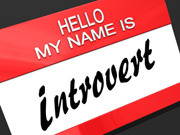
Courtesy of One Way Stock
The introverted author is by no means an unusual creature—far from it. The introverted nature works very well within the creative fields; it often accompanies a vivid imagination and attention to detail, which are fantastic for an author. Unfortunately for introverts, traditionally, that same nature went against the idea of marketing and sales.
Introverts do not enjoy big crowds and find socialising for any real length of time to be draining. This often leads to them fearing marketing as they have to deal with a good number of people for extensive periods. I've also noticed that introverts find marketing very unpleasant as they hate the idea of pushing themselves on others. All in all, they find it very difficult to get out there and promote their books.
The key to helping introverts become more comfortable with promotion and marketing is to change their perception of it. They are most likely to view it as shouting in a very crowded room, feeling rather small amongst the much louder, more confident voices. In this day and age, with social media marketing being the key for most authors, they don't need to shout at the crowd. Instead, they should focus on their strengths and the things they do enjoy: discussing their passions and making solid connections.

Courtesy of antony_mayfield
Introverts form very strong connections and often display incredible amounts of passion about the topics they fall in love with. This should be used to their advantage. An important part of marketing is engagement and building relationships; this means taking the time to show an interest in and genuinely interacting with people. That's great for introverts! This means they can focus on the one-on-one time and really shine on those topics which they're passionate about.
People love to feel wanted, appreciated, and listened to. Introverts excel at that. They're happy to listen and engage on that personal level, which leads to stronger connections and a healthier network. That network will then grow and give the introvert more people to share their passions with—which is where the introvert needs to focus. It's not about forcing your book on people; it's about making people shine, having them light up and come back to you again and again because they feel valued. Introverts should shift their focus from promotion proper and the idea of sales and numbers; instead it's all about those really happy moments and losing yourself in a conversation with a couple of people who share your enthusiasm and interests.
That probably seems like an odd way to approach it, but it makes sense when you understand that marketing is formed around what is often called 'the feel good factor'. One of the best ways to make people feel good is to encourage them to talk, to give them genuine attention and make them feel wanted. Sharing passions and providing new and interesting takes on them are fantastic ways to produce that feel-good factor. This will also form much stronger connections, which are then far more likely to support the introvert as an author. That support can come in the form of direct sales or promotion, as others spread the word and the passion.
People can't help but pay attention and be drawn in when someone talks passionately and shares their love of something. They adore people who give them real attention and make them feel good. Introverts are great at that. You're not bothering people; you're not pushing your book on anyone. You're just sharing your passions with the world and letting them take the next step of buying your book.

Laura Gallier is a passionate and driven literary marketing consultant originally from Southern England who took the leap and moved to Prague. She does digital marketing consultations with indie authors, her focus being social media marketing.
Laura works hard, pushes, takes risks and demands that life plays by her rules. During her free time she writes darker strains of fiction, and will self-publish her books once she finds time between marketing projects. Until then, she is working on a non-fiction marketing book aimed at helping indie authors understand how to market their books.
She can be found at Literary+, which she founded, and on Google+.
Also, I'm reminding everyone that our GOODREADS GIVEAWAY for The Emotion Thesaurus is running through September 18th, so if you'd like a print copy, put yourself in the draw! Lastly, Becca and I should have a release date soon for our upcoming Character Trait books, so if you'd like to be notified, just sign up here. AND, if you'd like a sneak peek at the Flaw Thesaurus Entry covering "MANIPULATIVE," you can find it in this month's newsletter!

Courtesy of One Way Stock
The introverted author is by no means an unusual creature—far from it. The introverted nature works very well within the creative fields; it often accompanies a vivid imagination and attention to detail, which are fantastic for an author. Unfortunately for introverts, traditionally, that same nature went against the idea of marketing and sales.
Introverts do not enjoy big crowds and find socialising for any real length of time to be draining. This often leads to them fearing marketing as they have to deal with a good number of people for extensive periods. I've also noticed that introverts find marketing very unpleasant as they hate the idea of pushing themselves on others. All in all, they find it very difficult to get out there and promote their books.
The key to helping introverts become more comfortable with promotion and marketing is to change their perception of it. They are most likely to view it as shouting in a very crowded room, feeling rather small amongst the much louder, more confident voices. In this day and age, with social media marketing being the key for most authors, they don't need to shout at the crowd. Instead, they should focus on their strengths and the things they do enjoy: discussing their passions and making solid connections.

Courtesy of antony_mayfield
Introverts form very strong connections and often display incredible amounts of passion about the topics they fall in love with. This should be used to their advantage. An important part of marketing is engagement and building relationships; this means taking the time to show an interest in and genuinely interacting with people. That's great for introverts! This means they can focus on the one-on-one time and really shine on those topics which they're passionate about.
People love to feel wanted, appreciated, and listened to. Introverts excel at that. They're happy to listen and engage on that personal level, which leads to stronger connections and a healthier network. That network will then grow and give the introvert more people to share their passions with—which is where the introvert needs to focus. It's not about forcing your book on people; it's about making people shine, having them light up and come back to you again and again because they feel valued. Introverts should shift their focus from promotion proper and the idea of sales and numbers; instead it's all about those really happy moments and losing yourself in a conversation with a couple of people who share your enthusiasm and interests.
That probably seems like an odd way to approach it, but it makes sense when you understand that marketing is formed around what is often called 'the feel good factor'. One of the best ways to make people feel good is to encourage them to talk, to give them genuine attention and make them feel wanted. Sharing passions and providing new and interesting takes on them are fantastic ways to produce that feel-good factor. This will also form much stronger connections, which are then far more likely to support the introvert as an author. That support can come in the form of direct sales or promotion, as others spread the word and the passion.
People can't help but pay attention and be drawn in when someone talks passionately and shares their love of something. They adore people who give them real attention and make them feel good. Introverts are great at that. You're not bothering people; you're not pushing your book on anyone. You're just sharing your passions with the world and letting them take the next step of buying your book.

Laura Gallier is a passionate and driven literary marketing consultant originally from Southern England who took the leap and moved to Prague. She does digital marketing consultations with indie authors, her focus being social media marketing.
Laura works hard, pushes, takes risks and demands that life plays by her rules. During her free time she writes darker strains of fiction, and will self-publish her books once she finds time between marketing projects. Until then, she is working on a non-fiction marketing book aimed at helping indie authors understand how to market their books.
She can be found at Literary+, which she founded, and on Google+.
Also, I'm reminding everyone that our GOODREADS GIVEAWAY for The Emotion Thesaurus is running through September 18th, so if you'd like a print copy, put yourself in the draw! Lastly, Becca and I should have a release date soon for our upcoming Character Trait books, so if you'd like to be notified, just sign up here. AND, if you'd like a sneak peek at the Flaw Thesaurus Entry covering "MANIPULATIVE," you can find it in this month's newsletter!

Published on August 28, 2013 04:00
August 24, 2013
Physical Attributes Entry: Slender Build
Physical description of a character can be difficult to convey—too much will slow the pace or feel 'list-like', while too little will not allow readers to form a clear mental image. If a reader cannot imagine what your character looks like, they may have trouble connecting with them on a personal level, or caring about their plight.
One way to balance the showing and telling of physical description is to showcase a few details that really help 'tell the story' about who your character is and what they've been through up to this point. Think about what makes them different and interesting. Can a unique feature, clothing choice or way they carry themselves help to hint at their personality? Also, consider how they move their body. Using movement will naturally show a character's physical characteristics, keep the pace flowing and help to convey their emotions.
SLENDER BUILD

Courtesy of Lynn Kelley Author, WANA Commons
Descriptors: slender, slim, thin, willowy, lean, lithe, lanky, skinny, svelte
Slender bodies are lean but not so skinny as to be considered unhealthy or underweight. Muscle tone may be evident due to a lack of body fat, but without deliberate attention, the muscles won't be pronounced or well-defined. Because of the long, thin nature of the limbs, fingers, and body, slender people often appear taller than they really are.
Famous Examples
Kate Middleton
Julia Roberts
Colin Farrell
Orlando Bloom
Gwyneth Paltrow
Simile and Metaphor Help:
What I loved best about Eve was the way she fit against my side when I pulled her to me—like a baby on its mother's hip. She matched me perfectly.
Twists on the Slender Cliché :
With the prevalence of body image issues in today's world, much emphasis is placed on the slender body type being the preferred one, particularly in children's and YA books. People with other builds can be just as healthy and well-adjusted; it would be nice to see these body types better represented in literature.
When it comes to men, those who less than athletic or muscular or often portrayed as unhealthy in some way. Men's bodies come in a variety of shapes, too. Twist the cliché by including the slender man who is confident and happy in his body.
Because slender bodies are neither large nor small, big or little, they can be easily forgotten or overlooked. This is where individual quirks and preferences come in. Clothing choices, skin color, birthmarks, freckles, piercings, tattoos, mannerisms, and other defining layers can turn a forgettable build into a memorable one.
HINT: When describing any part of the body, try to use cues that show the reader more than just a physical description. Make your descriptions do double duty. Example: I pretended interest in What's-His-Name's mind-numbing party chatter, but I couldn't stop looking at Sydney's brother. Describing him didn't do him justice—slim build, average height, brown hair. But there was something about the way he crossed the room, like he was the tallest person in it. His eyes always looked ready to laugh as he touched this person's shoulder, that one's back. Smothering a sigh, I dragged my attention back to What's-His-Name.
BONUS TIP: The Colors, Textures & Shapes Thesaurus in our sidebar might help you find a fresh take on some of the descriptors listed above!

Published on August 24, 2013 03:00
August 21, 2013
Sagging Middles: Fix Your Story's MUFFIN TOP!
You know how sometimes you get that awesome tingly feeling because a new book you want to read is out? Well Ta-Da, Structuring Your Novel is here at last. Following up on
Outlining Your Novel: Mapping Your Way To Success
, K.M. Weiland's newest writing book is all about creating a powerful impact through structure--both the outer plot and inner struggles taking place in the protagonist's character arc. Structure is something I like to study and I need to improve in, so this book is going to be a real help.
Speaking of help, please welcome K.M. Weiland to the blog! She's got a big topic on the table: the infamous SAGGING MIDDLE.
How Structure Prevents “Saggy Middle” Syndrome
by K.M. Weiland (@KMWeiland)
How do I fix my saggy middle? is a question I get a lot. Writers can find all sorts of info on fixing every other part of their story, but they’re often left hanging in regards to the middle. Some people are told to just “fill in the blanks” between the beginning and the ending. But that sort of advice is vague to the point of worthlessness. The middle is a big ol’ chunk of your story—almost twice as long as either the beginning or the ending. That’s a lot of space to navigate without any guidance more specific than “fill in the blanks.”
Is there a cure for the “saggy middle”?
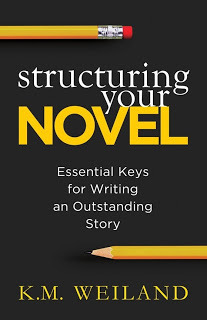
There sure is, and in a word (or two words, actually), that cure is story structure. Once you understand how to structure your story as a whole, you’ll be able to see how the middle of your story is not just a blank expanse to somehow be filled up with enough plot to push your character from the beginning to the end. Rather, the middle of your story—just like the beginning and the ending—is made up of several very specific components.
Technically, the middle of your story comprises the Second Act. This portion will take up about 50% of your story, beginning after the First Major Plot Point at the end of the First Act (roundabout the 25% mark in your book) and ending with the Third Major Plot Point that begins the Third Act (roundabout the 75% mark).
To truly understand how all these pieces fit together, you also need to gain a working knowledge of the First and Third Acts. But, for now, let’s just focus on the fixer-upper components needed for your saggy Second Act.
Structuring your Second Act, step by step
1. The First Half of the Second Act: Your First Act will end and your Second Act will begin with the First Major Plot Point a quarter of the way into your story (or thereabouts). This plot point will mark a major change in your character’s world. His status quo or “normal world” will be shaken. From here until the middle of the book, your protagonist is going to be in reaction mode. Everything he does will be an attempt to regain his balance after the drama and trauma of the First Plot Point. He will spend this section fighting his discomfort with wherever he is in life—but he won’t yet be ready to shake off his chains and do something dramatic about his discomfort.
Examples: In Star Wars: A New Hope, Luke scrambles to figure out where to go and who he’s supposed to be after his aunt and uncle are murdered in the First Plot Point. In Toy Story, Woody struggles to maintain his leadership position among the toys after Buzz arrives in the First Plot Point.
2. The Midpoint: Then, boom, halfway through your Second Act, smack in the middle of your story, something big happens. The Midpoint is going to be your strongest trick for preventing a saggy middle. This plot point will rock your character’s world just as hard as did the First Plot Point at the end of the First Act. But instead of throwing him into a series of reactions, the Midpoint will inspire him to finally stand up and start taking action. He still doesn’t have a lot of things figured out, but whatever happens in the Midpoint will inspire him to try to change his situation by taking the battle to the antagonistic force.
Examples: In Star Wars, Luke and company are captured by the Death Star. In Toy Story, Woody and Buzz get left behind at the gas station.
3. The Second Half of the Second Act: The entire second half of the Second Act is where your character will begin exploring his ability to take action. He may not know the right way to resist the antagonistic force, but he’s now determined he can no longer passively resist. He must stand up and do something. Your character will likely spend this portion of the story in a state of inner conflict: what he wants and what he needs (to resist and take action) won’t be the same thing, but he won’t yet be ready to completely relinquish either.
Examples: In Star Wars, Luke convinces Han and Chewie to help him rescue the princess. In Toy Story, Woody and Buzz try to get back to Andy.
4. The Third Plot Point: Finally, your Second Act will end and your Third Act will begin with a doozy of a Third Plot Point. This will turn out to be your character’s low point. All the actions he’s taken earlier will have led him to a place of sacrifice. Allies will have died, opportunities will have been dashed, and things will look pretty hopeless. This is where he will begin to realize that what he wants is likely standing in the way of what he needs. He will have to rise from the depths of this plot point with a new understanding of himself and, as a result, a better understanding of how to defeat the antagonistic force in the climactic Third Act.
Examples: In Star Wars, Luke and company escape the Death Star, but at the cost of Obi-Wan’s life. In Toy Story, Andy’s toys abandon Woody to Sid when he accidentally reveals Buzz’s broken arm.
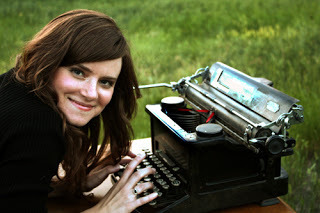
As you can see, the middle of your story isn’t a barren expanse at all. As long as you keep proper structure in mind, you will have guideposts to help you mold your plot all the way through. Done right and with imagination, your story’s middle will not only be manageable, it will also become the most interesting and important section of your story.
K.M. Weiland is the author of the epic
fantasy Dreamlander,
the historical western A
Man Called Outlaw and the medieval epic Behold
the Dawn . She enjoys mentoring other authors through her website Helping Writers Become
Authors, her books Outlining
Your Novel and Structuring Your
Novel, and her instructional CD Conquering Writer’s Block and
Summoning Inspiration. She makes her home in western Nebraska.
Two words: SO HELPFUL. I feel much better about shrinking my story's muffin top...how about you? Thank you Katie for sharing such valuable information on middles!
OH! And I should also mention that right now we're hosting a GOODREADS GIVEAWAY for The Emotion Thesaurus, so if you'd like a print copy, put yourself in the draw! Also, Becca and I should have a release date soon for our upcoming Character Trait books, so if you'd like to be notified, just sign up here. AND, if you'd like a sneak peek at the Flaw Thesaurus Entry covering "MANIPULATIVE," you can find it in this month's newsletter!

Speaking of help, please welcome K.M. Weiland to the blog! She's got a big topic on the table: the infamous SAGGING MIDDLE.
How Structure Prevents “Saggy Middle” Syndrome
by K.M. Weiland (@KMWeiland)
How do I fix my saggy middle? is a question I get a lot. Writers can find all sorts of info on fixing every other part of their story, but they’re often left hanging in regards to the middle. Some people are told to just “fill in the blanks” between the beginning and the ending. But that sort of advice is vague to the point of worthlessness. The middle is a big ol’ chunk of your story—almost twice as long as either the beginning or the ending. That’s a lot of space to navigate without any guidance more specific than “fill in the blanks.”
Is there a cure for the “saggy middle”?

There sure is, and in a word (or two words, actually), that cure is story structure. Once you understand how to structure your story as a whole, you’ll be able to see how the middle of your story is not just a blank expanse to somehow be filled up with enough plot to push your character from the beginning to the end. Rather, the middle of your story—just like the beginning and the ending—is made up of several very specific components.
Technically, the middle of your story comprises the Second Act. This portion will take up about 50% of your story, beginning after the First Major Plot Point at the end of the First Act (roundabout the 25% mark in your book) and ending with the Third Major Plot Point that begins the Third Act (roundabout the 75% mark).
To truly understand how all these pieces fit together, you also need to gain a working knowledge of the First and Third Acts. But, for now, let’s just focus on the fixer-upper components needed for your saggy Second Act.
Structuring your Second Act, step by step
1. The First Half of the Second Act: Your First Act will end and your Second Act will begin with the First Major Plot Point a quarter of the way into your story (or thereabouts). This plot point will mark a major change in your character’s world. His status quo or “normal world” will be shaken. From here until the middle of the book, your protagonist is going to be in reaction mode. Everything he does will be an attempt to regain his balance after the drama and trauma of the First Plot Point. He will spend this section fighting his discomfort with wherever he is in life—but he won’t yet be ready to shake off his chains and do something dramatic about his discomfort.
Examples: In Star Wars: A New Hope, Luke scrambles to figure out where to go and who he’s supposed to be after his aunt and uncle are murdered in the First Plot Point. In Toy Story, Woody struggles to maintain his leadership position among the toys after Buzz arrives in the First Plot Point.
2. The Midpoint: Then, boom, halfway through your Second Act, smack in the middle of your story, something big happens. The Midpoint is going to be your strongest trick for preventing a saggy middle. This plot point will rock your character’s world just as hard as did the First Plot Point at the end of the First Act. But instead of throwing him into a series of reactions, the Midpoint will inspire him to finally stand up and start taking action. He still doesn’t have a lot of things figured out, but whatever happens in the Midpoint will inspire him to try to change his situation by taking the battle to the antagonistic force.
Examples: In Star Wars, Luke and company are captured by the Death Star. In Toy Story, Woody and Buzz get left behind at the gas station.
3. The Second Half of the Second Act: The entire second half of the Second Act is where your character will begin exploring his ability to take action. He may not know the right way to resist the antagonistic force, but he’s now determined he can no longer passively resist. He must stand up and do something. Your character will likely spend this portion of the story in a state of inner conflict: what he wants and what he needs (to resist and take action) won’t be the same thing, but he won’t yet be ready to completely relinquish either.
Examples: In Star Wars, Luke convinces Han and Chewie to help him rescue the princess. In Toy Story, Woody and Buzz try to get back to Andy.
4. The Third Plot Point: Finally, your Second Act will end and your Third Act will begin with a doozy of a Third Plot Point. This will turn out to be your character’s low point. All the actions he’s taken earlier will have led him to a place of sacrifice. Allies will have died, opportunities will have been dashed, and things will look pretty hopeless. This is where he will begin to realize that what he wants is likely standing in the way of what he needs. He will have to rise from the depths of this plot point with a new understanding of himself and, as a result, a better understanding of how to defeat the antagonistic force in the climactic Third Act.
Examples: In Star Wars, Luke and company escape the Death Star, but at the cost of Obi-Wan’s life. In Toy Story, Andy’s toys abandon Woody to Sid when he accidentally reveals Buzz’s broken arm.

As you can see, the middle of your story isn’t a barren expanse at all. As long as you keep proper structure in mind, you will have guideposts to help you mold your plot all the way through. Done right and with imagination, your story’s middle will not only be manageable, it will also become the most interesting and important section of your story.
K.M. Weiland is the author of the epic
fantasy Dreamlander,
the historical western A
Man Called Outlaw and the medieval epic Behold
the Dawn . She enjoys mentoring other authors through her website Helping Writers Become
Authors, her books Outlining
Your Novel and Structuring Your
Novel, and her instructional CD Conquering Writer’s Block and
Summoning Inspiration. She makes her home in western Nebraska.
Two words: SO HELPFUL. I feel much better about shrinking my story's muffin top...how about you? Thank you Katie for sharing such valuable information on middles!
OH! And I should also mention that right now we're hosting a GOODREADS GIVEAWAY for The Emotion Thesaurus, so if you'd like a print copy, put yourself in the draw! Also, Becca and I should have a release date soon for our upcoming Character Trait books, so if you'd like to be notified, just sign up here. AND, if you'd like a sneak peek at the Flaw Thesaurus Entry covering "MANIPULATIVE," you can find it in this month's newsletter!

Published on August 21, 2013 03:30
August 17, 2013
Physical Attributes Entry: MUSCULAR CHARACTERS
Physical description of a character can be difficult to
convey—too much will slow the pace or feel 'list-like', while too
little will not allow readers to form a clear mental image. If a reader
cannot imagine what your character looks like, they may have trouble
connecting with them on a personal level, or caring about their plight.

Muscle Dominator via photopin cc
One
way to balance the showing and telling of physical description is to
showcase a few details that really help 'tell the story' about who your
character is and what they've been through up to this point. Think about
what makes them different and interesting. Can a unique feature,
clothing choice or way they carry themselves help to hint at their
personality? Also, consider how they move their body. Using movement
will naturally show a character's physical characteristics, keep the
pace flowing and help to convey their emotions.
MUSCULAR
Descriptors : brawny, beefy, built, stacked, burly, hulking, robust, powerful, sculpted, sturdy,
strapping, rugged, hard, potent. Muscular individuals go beyond toned muscle structure and verge into defined, well built curves often visible through clothing. Muscles strain against fabric at the forearms, biceps and chest. Calves are bulkier than normal, the back broadened with muscle layers and a neck may appear wider at the base. Muscular individuals are not that way naturally, and so either go to the gym or work in an environment that requires strength, building them up over time. Muscular characters can take their desire for a sculpted look too far and become a mass of veiny, bulges that many find unattractive.
Things Muscles Do:
Flex: jump, bulge, ripple, jerk, strain, swell, rise, balloon
Harden: tense, firm, freeze, set, strengthen, knot, bunch
Key Emotions and Related Muscle Movements:
Anger: when angry or frustrated, muscles tense in aggression. The body naturally takes up more space, creating a bigger target and sending a message to opponents that one should not be messed with.
Fear: When experiencing fear, a person feels the desire to shrink and make oneself less of a target, aligning with flight-or-flight. Muscles may loosen as one tries to make oneself smaller, or tighten in an attempt to shield oneself from harm.
Pride: Creating a muscular build takes time, effort, and discipline. Often the person feels pride and confidence as a result, especially males. This pride can escalate to overblown self-confidence or narcissism.
Simile and Metaphor Help:
Metallica came on and Randy began flexing his bulky chest muscles to the beat. Valerie and I roared; they jittered like twin bowls of Jello left on the counter during an earthquake.
Holy cow, is that Alicia? I almost didn't recognize my high school chum by her sage eyes and sweet smile, so distracted was I by the knotted lumps beneath her leathery fake tan. I'd heard she'd gotten into body building, but unless she was moonlighting as a baseball stadium storage bin, it looked like she'd taken her fitness just a little to far.
Clichés to Avoid : muscles the size of beach balls, a muscle-bound body builder with no brains, flexing an arm muscle to impress, etc.
BONUS TIP: The
Colors, Textures & Shapes Thesaurus in our sidebar might help
you find a fresh take on some of the descriptors listed above!

convey—too much will slow the pace or feel 'list-like', while too
little will not allow readers to form a clear mental image. If a reader
cannot imagine what your character looks like, they may have trouble
connecting with them on a personal level, or caring about their plight.

Muscle Dominator via photopin cc
One
way to balance the showing and telling of physical description is to
showcase a few details that really help 'tell the story' about who your
character is and what they've been through up to this point. Think about
what makes them different and interesting. Can a unique feature,
clothing choice or way they carry themselves help to hint at their
personality? Also, consider how they move their body. Using movement
will naturally show a character's physical characteristics, keep the
pace flowing and help to convey their emotions.
MUSCULAR
Descriptors : brawny, beefy, built, stacked, burly, hulking, robust, powerful, sculpted, sturdy,
strapping, rugged, hard, potent. Muscular individuals go beyond toned muscle structure and verge into defined, well built curves often visible through clothing. Muscles strain against fabric at the forearms, biceps and chest. Calves are bulkier than normal, the back broadened with muscle layers and a neck may appear wider at the base. Muscular individuals are not that way naturally, and so either go to the gym or work in an environment that requires strength, building them up over time. Muscular characters can take their desire for a sculpted look too far and become a mass of veiny, bulges that many find unattractive.
Things Muscles Do:
Flex: jump, bulge, ripple, jerk, strain, swell, rise, balloon
Harden: tense, firm, freeze, set, strengthen, knot, bunch
Key Emotions and Related Muscle Movements:
Anger: when angry or frustrated, muscles tense in aggression. The body naturally takes up more space, creating a bigger target and sending a message to opponents that one should not be messed with.
Fear: When experiencing fear, a person feels the desire to shrink and make oneself less of a target, aligning with flight-or-flight. Muscles may loosen as one tries to make oneself smaller, or tighten in an attempt to shield oneself from harm.
Pride: Creating a muscular build takes time, effort, and discipline. Often the person feels pride and confidence as a result, especially males. This pride can escalate to overblown self-confidence or narcissism.
Simile and Metaphor Help:
Metallica came on and Randy began flexing his bulky chest muscles to the beat. Valerie and I roared; they jittered like twin bowls of Jello left on the counter during an earthquake.
Holy cow, is that Alicia? I almost didn't recognize my high school chum by her sage eyes and sweet smile, so distracted was I by the knotted lumps beneath her leathery fake tan. I'd heard she'd gotten into body building, but unless she was moonlighting as a baseball stadium storage bin, it looked like she'd taken her fitness just a little to far.
Clichés to Avoid : muscles the size of beach balls, a muscle-bound body builder with no brains, flexing an arm muscle to impress, etc.
BONUS TIP: The
Colors, Textures & Shapes Thesaurus in our sidebar might help
you find a fresh take on some of the descriptors listed above!

Published on August 17, 2013 03:30
August 14, 2013
Get Into The Fight: How to Write Action That Won’t Show You’ve Never Thrown a Punch
Our books are getting so close to being finished! We're in that weird almost-done stage where you can see the finish line but you still have so much left to do, and there are roughly a million decisions to be made. And all of this is happening as my daughter starts kindergarten this week.
*cue head exploding*
I admit to being more than a little crabby. I'm not quite to the point of wanting to smack people, but I'm close. Which is why I'm so grateful that Erin Flynn is here today to talk about....FIGHT SCENES! Just...you know. Strictly from a research standpoint...
**************
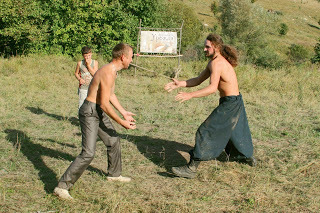
By Лобачев Владимир (Own work) [CC0], via Wikimedia Commons
I’m an enigma in that I’m a romance author who likes to write a lot of action into her books. An interesting side effect came about from that, though: lots of romance authors asking me on a regular basis to consult on their action or fighting scenes.
What amazes me is how often I talk to other authors who are baffled by the questions I ask them. Did you do any research? Some are honest and say they didn’t know where to start. Others act like I’m the twit and inform me there’s no way to research fighting.
Actually, there is. I’m a Chicagoian with an Irish temper, so depending on how snippy someone is, my reply can range from a nice suggestion of starting points to an offer of learning firsthand. Honestly, I say it to make a point—not that they should get in a fight, but that they could watch one.
I tell most authors seeking help that studying MMA fights is a great way to understand technique, timing, reaction, gut responses, and such that I see mucked up all the time in books with action sequences.
Here are some of the most common pitfalls.
Balance . A person can’t throw a punch with their right hand and step with their left foot. Punching is about more than the hand or arm. To cause any damage, the whole body is behind a punch and has to be on the same page.
Taking hits with no recourse. I can always tell when someone has never been punched. They write their characters getting punched in the face as if they’re dropping a piece of paper on their heads. Let me tell you, it hurts. It really hurts if the person knows what they’re doing. Your characters will stumble backwards, see spots in their vision, experiencing ringing in their ears, feel bones snapping, and so on. And don’t forget to make your characters feel the fight afterwards. They will hurt from it!
Timing . People are not semi-automatic weapons. It takes a bit of time to reset to throw another punch or get into position. It’s why boxers and fighters “dance” around so much. Give your characters a chance to assess their opponents. These are moving targets and oppositions with a plethora of variable components.
The fingers wrapped over the thumb in a fist. The second that fist comes into contact with something hard and un-malleable—say bone under skin—that thumb will break. It’s broken, no ifs, ands, or butts. Maybe even shattered, and the hand is out for the count. The thumb goes on the outside of a fist.
I’ll share my favorite mistake only because those who winced while reading the list of pitfalls will feel better when they hear this. So, it’s a New York Times bestselling author, proving that we all make mistakes.
The author goes into detail about two guys goofing around—best of friends, shoulder to shoulder once again as they patrol the streets to keep them safe. Fred, who’s on Ted’s right, just as they’re on the right side of justice (yes, it said something like that, though they weren’t Ted and Fred) is listening all about Ted’s new woman.
Suddenly they’re attacked! Ted sees them first, grabs his sword, and extends it over his right shoulder to gain momentum before striking out at the enemy. Crisis averted, Ted saved the day.
Anyone else catch that? Yeah, apparently Fred wasn’t that great of a friend because Ted just beheaded him…or at least cut the guy up something fierce.
That is why I always tell authors and writers to physically draw their action scenes. It might sound silly or weird, but I have over a hundred books as Erin and my pen name Joyee, and I’ve drawn out every fight sequence, bomb scene, car chase, or anything that gets remotely complicated.
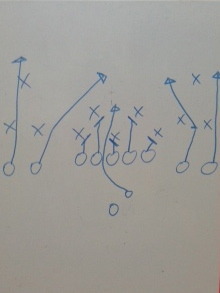
It doesn’t have to be fancy. Heck, my neighbor thought I was a football coach because he used to see me in my garage drawing X’s and O’s with arrows on my whiteboards all the time. But it works. It works for the NFL, doesn’t it? Movie stunt coordinators do it before filming as well.
First, I map out the location. Once I know what I’m working with, I mark up my available space. It’s also helpful for the visualization when it comes time to write the description of the room, but I’ll leave that article to someone else.
Hopefully this post showed that there are lots of tools out there to help with action and fight scenes other than jumping into a bar brawl. Though, those are always good fun, too.
Not that I’d know anything about that.

Growing up on the northwest side of Chicago, Erin is a loyal Cubs fan, but she also admits to being a die-hard Green Bay Packers girl. From target practice to putting puzzles together, she enjoys an eclectic list of hobbies that feed her outgoing and creative personality. To date, she has published over 90 books in the erotic romance genre, and her dedicated readers eagerly await each installment to her numerous series.
*cue head exploding*
I admit to being more than a little crabby. I'm not quite to the point of wanting to smack people, but I'm close. Which is why I'm so grateful that Erin Flynn is here today to talk about....FIGHT SCENES! Just...you know. Strictly from a research standpoint...
**************

By Лобачев Владимир (Own work) [CC0], via Wikimedia Commons
I’m an enigma in that I’m a romance author who likes to write a lot of action into her books. An interesting side effect came about from that, though: lots of romance authors asking me on a regular basis to consult on their action or fighting scenes.
What amazes me is how often I talk to other authors who are baffled by the questions I ask them. Did you do any research? Some are honest and say they didn’t know where to start. Others act like I’m the twit and inform me there’s no way to research fighting.
Actually, there is. I’m a Chicagoian with an Irish temper, so depending on how snippy someone is, my reply can range from a nice suggestion of starting points to an offer of learning firsthand. Honestly, I say it to make a point—not that they should get in a fight, but that they could watch one.
I tell most authors seeking help that studying MMA fights is a great way to understand technique, timing, reaction, gut responses, and such that I see mucked up all the time in books with action sequences.
Here are some of the most common pitfalls.
Balance . A person can’t throw a punch with their right hand and step with their left foot. Punching is about more than the hand or arm. To cause any damage, the whole body is behind a punch and has to be on the same page.
Taking hits with no recourse. I can always tell when someone has never been punched. They write their characters getting punched in the face as if they’re dropping a piece of paper on their heads. Let me tell you, it hurts. It really hurts if the person knows what they’re doing. Your characters will stumble backwards, see spots in their vision, experiencing ringing in their ears, feel bones snapping, and so on. And don’t forget to make your characters feel the fight afterwards. They will hurt from it!
Timing . People are not semi-automatic weapons. It takes a bit of time to reset to throw another punch or get into position. It’s why boxers and fighters “dance” around so much. Give your characters a chance to assess their opponents. These are moving targets and oppositions with a plethora of variable components.
The fingers wrapped over the thumb in a fist. The second that fist comes into contact with something hard and un-malleable—say bone under skin—that thumb will break. It’s broken, no ifs, ands, or butts. Maybe even shattered, and the hand is out for the count. The thumb goes on the outside of a fist.
I’ll share my favorite mistake only because those who winced while reading the list of pitfalls will feel better when they hear this. So, it’s a New York Times bestselling author, proving that we all make mistakes.
The author goes into detail about two guys goofing around—best of friends, shoulder to shoulder once again as they patrol the streets to keep them safe. Fred, who’s on Ted’s right, just as they’re on the right side of justice (yes, it said something like that, though they weren’t Ted and Fred) is listening all about Ted’s new woman.
Suddenly they’re attacked! Ted sees them first, grabs his sword, and extends it over his right shoulder to gain momentum before striking out at the enemy. Crisis averted, Ted saved the day.
Anyone else catch that? Yeah, apparently Fred wasn’t that great of a friend because Ted just beheaded him…or at least cut the guy up something fierce.
That is why I always tell authors and writers to physically draw their action scenes. It might sound silly or weird, but I have over a hundred books as Erin and my pen name Joyee, and I’ve drawn out every fight sequence, bomb scene, car chase, or anything that gets remotely complicated.

It doesn’t have to be fancy. Heck, my neighbor thought I was a football coach because he used to see me in my garage drawing X’s and O’s with arrows on my whiteboards all the time. But it works. It works for the NFL, doesn’t it? Movie stunt coordinators do it before filming as well.
First, I map out the location. Once I know what I’m working with, I mark up my available space. It’s also helpful for the visualization when it comes time to write the description of the room, but I’ll leave that article to someone else.
Hopefully this post showed that there are lots of tools out there to help with action and fight scenes other than jumping into a bar brawl. Though, those are always good fun, too.
Not that I’d know anything about that.

Growing up on the northwest side of Chicago, Erin is a loyal Cubs fan, but she also admits to being a die-hard Green Bay Packers girl. From target practice to putting puzzles together, she enjoys an eclectic list of hobbies that feed her outgoing and creative personality. To date, she has published over 90 books in the erotic romance genre, and her dedicated readers eagerly await each installment to her numerous series.

Published on August 14, 2013 04:00
August 7, 2013
The Big Lie: Encouraging your Readers to Suspend Disbelief
As many of you may know, Angela and I are eyebrow-deep in edits for our Traits Thesaurus. With a lot of luck and Mountain Dew, they should be available within the next few months.
*exhausted squeak*
In the meantime, Laura Pauling has pushed through the publishing craziness and is releasing her newest book next week. I had the pleasure of reading an advanced copy of HEIST while I was on vacation, and, as you can see from my Goodreads review, I THOROUGHLY enjoyed it.
Laura is kind of...well, let's be honest. She's obsessed with spies. So I was thrilled when she offered to write at The Bookshelf Muse about The Big Lie...
*******
Suspension of disbelief is the ability to accept the core
premise of a story as truth. It usually refers to an unbelievable element such
as magic, time travel, or entering a magical land through a wardrobe. Suspending belief is
both easy and hard to do.
I love entering a movie or a book with a premise I’m excited
about. I’ve made it real easy for the writer because I’ve already suspended my
belief. But it’s up to them to keep it suspended. Every plot point, every
complication, every twist, they need to prove it again.
Honestly, I think this is just as hard to do with
contemporary realistic fiction as it is to do with a time travel thriller. In
fact, it may be harder, but that’s another post.
Some quick and easy tips
for creating The Big Lie in fiction:
Don’t break the world building rules you’ve already
established.
The action/reaction of your characters in the world and
to the world need to make sense within the context of the story.
Bring small world building details into the story wherever
you can as long as they pertain to the scene. Don’t just drop them in randomly
or over do it.
Make sure your character's emotional arc and actions
are logical because if the reader doesn’t whole-heartedly believe in your
character then they are less likely to believe in your premise.
For me the most important way to lend believability…is
the writing. Good writing gets me every time and that just takes time and hard
work.
Don’t make your readers mad by not truly answering the
story questions/mysteries you’ve presented. Don’t give them the run-around.

One TV show where I think the writers may have pushed it too
far was LOST. They got so fantastical with some of the events that it was just
about impossible for them to present a logical explanation that viewers could
believe. Then they made some viewers mad by getting a little cheesy with the
fountain of youth explanation. This turned many people off.
Me? I loved the whole show and never wavered. I was so
invested in the characters that I overlooked everything. There’s definitely a
lesson to be learned there.
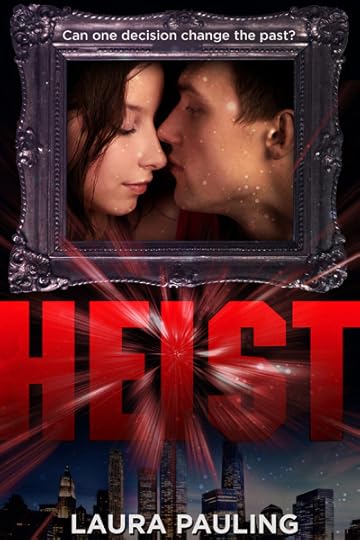
HEIST is a time travel thriller. Think The Butterfly Effect as a YA novel. I ask the reader to believe in
time travel. That’s my big lie. Each time Jack Brodie travels back to the
Gardner Museum Heist to fix his mistakes and his world in the future changes
for the worse, I have to convince my readers to believe the lie again. (And I hope they do!)
In what books or movies did you believe The Big Lie? I'd love to hear your examples.

Laura Pauling writes about spies, murder and mystery. She's also the author of the Circle of Spies Series: A Spy Like Me, Heart of an Assassin and the forthcoming Twist of Fate. She writes to entertain and experience a great story...and be able to work in her jammies and slippers. Her book HEIST releases August 15th. Check it out on Goodreads.

Published on August 07, 2013 04:00
Writers Helping Writers
A place for writers to find support, helpful articles on writing craft, and an array of unique (and free!) writing tools you can't find elsewhere. We are known far and wide for our "Descriptive Thesau
A place for writers to find support, helpful articles on writing craft, and an array of unique (and free!) writing tools you can't find elsewhere. We are known far and wide for our "Descriptive Thesaurus Collections" which help authors create vivid imagery and sensory detail for their Settings, Characters (physical descriptions, emotions, skills & talents, etc.), Symbolism, Weather, and a whole bunch more. Stop in and say hello! :) http://writershelpingwriters.net/
...more
- Angela Ackerman's profile
- 1023 followers



